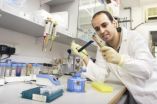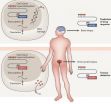(Press-News.org) Baltimore, MD —You may think you have dinner all to yourself, but you're actually sharing it with a vast community of microbes waiting within your digestive tract. A new study from a team including Carnegie's Steve Farber and Juliana Carten reveals that some gut microbes increase the absorption of dietary fats, allowing the host organism to extract more calories from the same amount of food.
Previous studies showed gut microbes aid in the breakdown of complex carbohydrates, but their role in dietary fat metabolism remained a mystery, until now. The research is published September 13 by Cell Host & Microbe.
"This study is the first to demonstrate that microbes can promote the absorption of dietary fats in the intestine and their subsequent metabolism in the body," said senior study author John Rawls of the University of North Carolina. "The results underscore the complex relationship between microbes, diet and host physiology."
The study was carried out in zebrafish, which are optically transparent when young. By feeding the fish fatty acids tagged with fluorescent dyes, an approach originally developed in Farber's lab, the researchers were able to directly observe the absorption and transport of fats in live animals. The Rawl's lab pioneered methods to grow zebrafish larvae in the presence or absence of gut microbes.
By combining approaches, they determined that one type of bacteria, called Firmicutes, is instrumental in increasing fat absorption. They also found that the abundance of Firmicutes in the gut was influenced by diet. Fish fed normally had more Firmicutes than fish that were denied food for several days. Other studies have linked a higher relative abundance of Firmicutes in the gut with obesity in humans.
The findings indicate that bacteria in the gut can increase the host's ability to absorb fat and thereby harvest more calories from the diet. Another implication is that a high-fat diet promotes the growth of these fat-loving Firmicutes, resulting in more fat absorption.
Although the study involved only fish, not humans, it offers insights that could help inform new approaches to treating obesity and other disorders.
"The unique properties of zebrafish larvae are helping us develop a better understanding of how the intestine functions with the goal of contributing to ongoing efforts to reduce the impact of diseases associated with altered lipid metabolism, such as diabetes, obesity, and cardiovascular disease. Our collaboration with the Rawls lab is now focused on how specific gut bacteria are able to stimulate absorption of dietary fat. We hope to use that information to develop new ways to reduce fat absorption in the context of human diseases," Farber said.
The research team also included lead author Ivana Semova and co-author Lantz Mackey, both of UNC, as well as co-authors Jesse Stombaugh and Rob Knight of the University of Colorado at Boulder.
INFORMATION:
This work was funded by grants from NIH. Additional funding was provided by the Pilot Project Award from the UNC Center for Environmental Health and Susceptibility, a Pew Scholars in the Biomedical Sciences award, the Carnegie Institution for Science endowment, the G. Harold and Leila Y. Mathers Charitable Foundation, the Howard Hughes Medical, and the Susan Fellner Physiology Graduate Student Fellowship (UNC-Chapel Hill).
The Carnegie Institution for Science is a private, nonprofit organization headquartered in Washington, D.C., with six research departments throughout the U.S. Since its founding in 1902, the Carnegie Institution has been a pioneering force in basic scientific research. Carnegie scientists are leaders in plant biology, developmental biology, astronomy, materials science, global ecology, and Earth and planetary science.
END
LIVERMORE, Calif.— U.S. energy policy should simultaneously pursue security of its energy supply, economic stability and reduced environmental impacts, says a national poll of energy professionals jointly prepared by Sandia National Laboratories and OurEnergyPolicy.org.
The findings of the national poll, "The Goals of Energy Policy," show that the vast majority — more than 85 percent — of the 884 energy professionals surveyed prefer policymaking that pursues all three goals at once.
The poll asked the experts to allocate 100 points, representing a 100 percent policymaking ...
A new paper appearing in the September 2012 edition of the Bulletin of The American Ceramic Society for the first time provides a scientific explanation of why some glass cookware sold in the United States is more susceptible than others to "explosive" shattering and the possibility of exposing consumers to injury from flying glass shards.
Clear glass baking dishes and pots are a staple in many households around the world and have been since they were first introduced in 1915 to consumers by the Corning Glass Works, which created the Pyrex brand name. The original Pyrex ...
PARSONS, W. Va., September 12, 2012 – Using old deeds and witness trees, a U.S. Forest Service scientist has created a glimpse of the composition of the forests that covered today's Monongahela National Forest before settlement and logging changed the landscape.
"European Settlement-Era Vegetation of the Monongahela National Forest, West Virginia" describes how a Forest Service scientist and her West Virginia University colleague answered questions about the composition of early forests using a unique dataset. The dataset was built with original deeds, metes and bounds ...
Vegas, Monte Carlo, and Atlantic City draw people from around the world who are willing to throw the dice and take their chances. Researchers from the Technical University of Lodz, Poland, have spotted something predictable in the seemingly random throw of the dice. By applying chaos theory and some high school level mechanics, they determined that by knowing the initial conditions – such as the viscosity of the air, the acceleration of gravity, and the friction of the table – it should be possible to predict the outcome when rolling the dice.
The researchers created ...
New research from the Hebrew University of Jerusalem shows that a carefully scheduled high-fat diet can lead to a reduction in body weight and a unique metabolism in which ingested fats are not stored, but rather used for energy at times when no food is available.
The research was conducted by Prof. Oren Froy along with Prof. Zecharia Madar, research student Yoni Genzer and research fellow Dr. Hadas Sherman at the Institute of Biochemistry, Food Science and Nutrition, at the Hebrew University's Robert H. Smith Faculty of Agriculture, Food and Environment. The results ...
The research team led by Manel Esteller, director of the Cancer Epigenetics and Biology Program at the Bellvitge Biomedical Research Institute (IDIBELL), professor of genetics at the University of Barcelona and ICREA researcher, has updated the latest findings in applied epigenetics in a review paper published in Nature Reviews Genetics.
There is a growing need for better biomarkers that allow early detection of human diseases, especially cancer. The markers can improve primary prevention, diagnosis and prognosis of disease. Furthermore, it is possible to predict which ...
OTTAWA, Canada, September 12, 2012—Vitamin D is increasingly being recognized as important for good health. Vitamin D is a hormone made in the skin following sun exposure or acquired from diet and supplement intake. Previous medical research has shown that low body levels of vitamin D make people more susceptible to problems such as bone fractures, poor mental health and infections like the common cold. Until recently, there had been little consideration given to the role of vitamin D in more severe diseases, which is why Dr. Dayre McNally's recent publication in the esteemed ...
CINCINNATI – New research indicates marijuana-like compounds called endocannabinoids alter genes and biological signals critical to the formation of a normal placenta during pregnancy and may contribute to pregnancy complications like preeclampsia.
A study in the Sept. 14 edition of The Journal of Biological Chemistry offers new evidence that abnormal biological signaling by endocannabinoid lipid molecules produced by the body disrupts the movement of early embryonic cells important to a healthy pregnancy, in particular trophoblast cells that form the placenta. Abnormal ...
Historic findings of human remains- including a man with apparent battle wounds and curvature of the spine - have been revealed by an archaeological team from the University of Leicester.
The University of Leicester has been leading the archaeological search for the burial place of King Richard III with Leicester City Council, in association with the Richard III Society. The dig, now in its third week, has yielded dramatic findings of human remains which the University will now subject to rigorous laboratory tests.
The stunning findings of human remains excavated by ...
An important breakthrough could help in the fight against myotonic dystrophy. The discovery, recently published in the prestigious scientific journal Cell, results from an international collaboration between researchers at the IRCM, the Massachusetts Institute of Technology (MIT), the University of Southern California and Illumina. Their findings could lead to a better understanding of the causes of this disease.
Myotonic dystrophy (DM), also known as Steinert's disease, is the most common form of muscular dystrophies seen in adults. This disorder is characterized by ...



